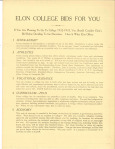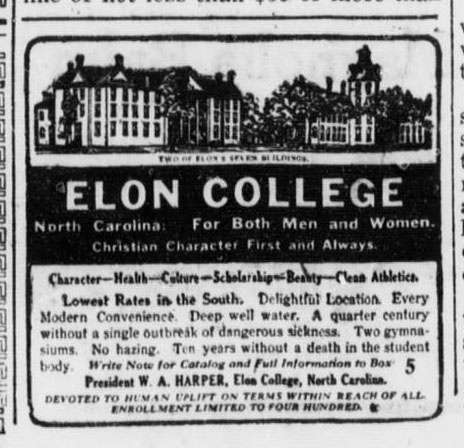Advertising Elon
Shannon Tennant
October 28, 2013
Think back to when you first heard about Elon University and first considered coming here. What influenced your decision? At some point in the process, you saw an ad that extolled the virtues of the school. In magazines, on billboards, in brochures, on the internet – Elon’s advertisements are everywhere.
Universities have come to realize that they are businesses, and they need to reach prospective customers. Elon has to market its image to attract top quality students in this competitive environment. But what that image is, and how to best present it, has changed over the years.
Here is an ad from the Asheville newspaper in 1917. Some of the attractions Elon lists seem amusing now. Well water is not so important when we all drink bottled water. What about no outbreaks of “dangerous sickness?” They obviously don’t mean the cold that you caught from your suitemate. But a healthy environment was very important in the days before antibiotics and modern medical testing. Only a few short months after this advertisement ran, the world suffered a global influenza pandemic. Over 50 million people died worldwide and an estimated 13,000 people died in North Carolina. Check out this post about Elon’s experience with the disease.
 College affordability is an important issue today. Elon is justly proud of its ranking as a “best value” university by Kiplinger for the last several years. But how much more important was it during the Great Depression! This prospectus from 1932 makes a good case for Elon’s value. Imagine getting your Elon education for less than $400 a year. That is an “amazingly low cost,” though still more money than most people could afford. Elon’s enrollment dwindled to a mere 87 students during the Depression, which was barely enough to keep the school open. It was important to stress that Elon was a good investment and would lead to a good job at a time when over 20% of Americans were unemployed.
College affordability is an important issue today. Elon is justly proud of its ranking as a “best value” university by Kiplinger for the last several years. But how much more important was it during the Great Depression! This prospectus from 1932 makes a good case for Elon’s value. Imagine getting your Elon education for less than $400 a year. That is an “amazingly low cost,” though still more money than most people could afford. Elon’s enrollment dwindled to a mere 87 students during the Depression, which was barely enough to keep the school open. It was important to stress that Elon was a good investment and would lead to a good job at a time when over 20% of Americans were unemployed.
By the end of the 1930s, the economy has improved and more students were able to afford to come to Elon. But everything cha nged on December 7, 1941 with the attack on Pearl Harbor and the United States’ entry into World War II. Several hundred students (and 13 faculty) left Elon to serve their country. But Elon stayed open, and adjusted its advertising and curriculum to attract the young people who remained at home. This brochure from the mid-1940s promotes Elon’s business curriculum in the context of patriotically serving the war effort. Students would be able to help their country and still have access to the “cultural advantages of college life.” Also notice the unique War Curriculum that Elon offered during this period. The aeronautics courses were especially useful because there was an Army Air Corps training detachment stationed at Elon. Courses in “Use of Gas Masks” or “Black-out” seem almost humorous now, but it wasn’t hard to see the application when reading the daily events in Europe and the Pacific. Look at this post for more details about the Air Corps trainees.
nged on December 7, 1941 with the attack on Pearl Harbor and the United States’ entry into World War II. Several hundred students (and 13 faculty) left Elon to serve their country. But Elon stayed open, and adjusted its advertising and curriculum to attract the young people who remained at home. This brochure from the mid-1940s promotes Elon’s business curriculum in the context of patriotically serving the war effort. Students would be able to help their country and still have access to the “cultural advantages of college life.” Also notice the unique War Curriculum that Elon offered during this period. The aeronautics courses were especially useful because there was an Army Air Corps training detachment stationed at Elon. Courses in “Use of Gas Masks” or “Black-out” seem almost humorous now, but it wasn’t hard to see the application when reading the daily events in Europe and the Pacific. Look at this post for more details about the Air Corps trainees.
After the war, thousands of returning soldiers were able to take advantage of the G.I. Bill to begin or res ume their studies. As this advertisement from 1946 shows, Elon advertised itself to appeal to veterans. President Smith’s letter touches on the patriotic themes of service and freedom that would resonate with anyone who had served in the war effort. The special accommodations for veterans with families would be especially attractive, since the Baby Boom was already underway. Notice that affordability is still a major selling point. The G.I. Bill paid for tuition but not all college costs. The “splendid living environment” of Elon must have seemed like heaven compared to the battlefield.
ume their studies. As this advertisement from 1946 shows, Elon advertised itself to appeal to veterans. President Smith’s letter touches on the patriotic themes of service and freedom that would resonate with anyone who had served in the war effort. The special accommodations for veterans with families would be especially attractive, since the Baby Boom was already underway. Notice that affordability is still a major selling point. The G.I. Bill paid for tuition but not all college costs. The “splendid living environment” of Elon must have seemed like heaven compared to the battlefield.
Fast forward to the 1980s – time for the Baby Boomers’ children to choose a college. What a difference a few decades make! Look at the color, look at the students, look at their hair! But Elon’s message is not so different. Elon highlights their great curriculum, athletics, career planning– and it’s all still available for a reasonable cost. The “delightful location” that was advertised in 1917 has been described a little differently. It’s not enough now to have a beautiful campus. Elon is close to other cultural and “big city” opportunities. Who wouldn’t want to see Bruce Springsteen? It is interesting to see the seeds of so many current Elon programs. The “full year orientation” for freshmen is now Elon 101. The School of Communications still offers “radio, TV, and newspaper production” and much more. And affordability was still a concern, when Elon was competing with public state universities.
Look at the color, look at the students, look at their hair! But Elon’s message is not so different. Elon highlights their great curriculum, athletics, career planning– and it’s all still available for a reasonable cost. The “delightful location” that was advertised in 1917 has been described a little differently. It’s not enough now to have a beautiful campus. Elon is close to other cultural and “big city” opportunities. Who wouldn’t want to see Bruce Springsteen? It is interesting to see the seeds of so many current Elon programs. The “full year orientation” for freshmen is now Elon 101. The School of Communications still offers “radio, TV, and newspaper production” and much more. And affordability was still a concern, when Elon was competing with public state universities.
Don Draper says in the first season of Mad Men, “Advertising is based on one thing: happiness.” Elon is promoting other features, like academic excellence, relevant courses, great living and recreational facilities, and of course a reasonable price tag. But all of these experiences add up to that one basic idea: at Elon, you will be happy!

Leave a Reply